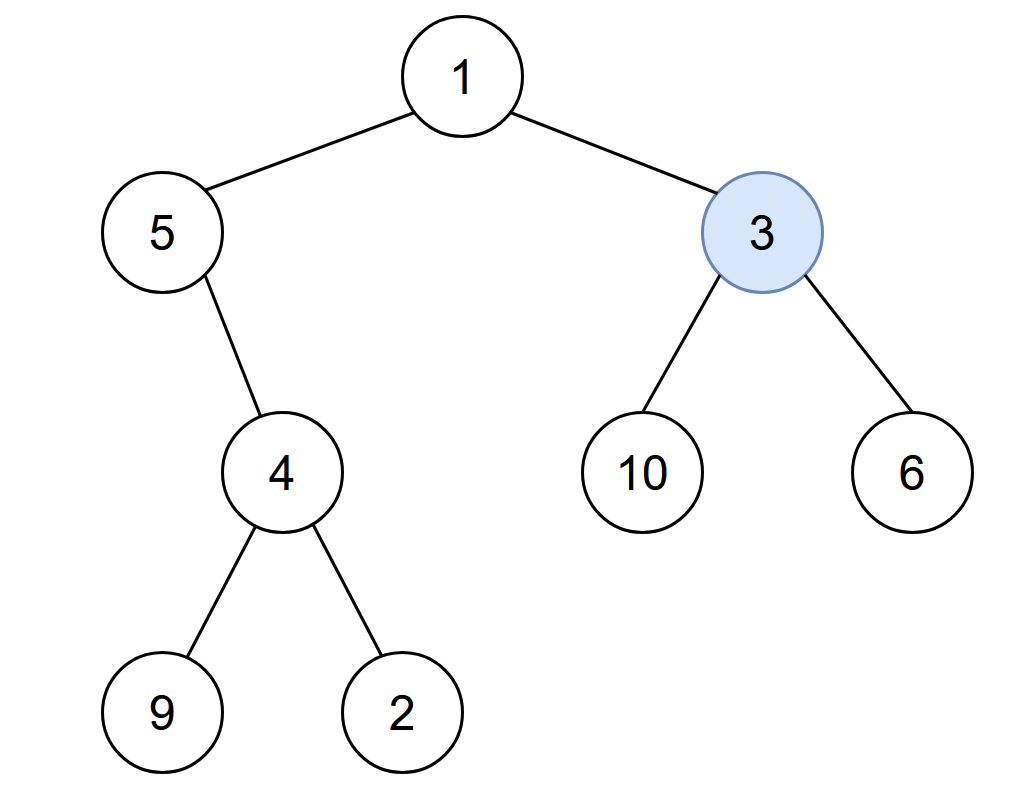LeetCode 2385 solution

2385. Amount of Time for Binary Tree to be Infected
#Medium #BFS #DFS #Binary Tree
problem
You are given therootof a binary tree with unique values, and an integerstart. At minute0, an infection starts from the node with valuestart.
Each minute, a node becomes infected if:
The node is currently uninfected.
The node is adjacent to an infected node.
Return the number of minutes needed for the entire tree to be infected.
Example 1:

- Input: root = [1,5,3,null,4,10,6,9,2], start = 3
- Output: 4
- Explanation: The following nodes are infected during:
- Minute 0: Node 3
- Minute 1: Nodes 1, 10 and 6
- Minute 2: Node 5
- Minute 3: Node 4
- Minute 4: Nodes 9 and 2
It takes 4 minutes for the whole tree to be infected so we return 4.
python
# Definition for a binary tree node.
# class TreeNode:
# def __init__(self, val=0, left=None, right=None):
# self.val = val
# self.left = left
# self.right = right
from collections import deque, defaultdict
class Solution:
def amountOfTime(self, root: Optional[TreeNode], start: int) -> int:
graph = defaultdict(list)
def build_graph(node,parent):
if node:
if parent:
graph[node.val].append(parent.val)
graph[parent.val].append(node.val)
build_graph(node.left,node)
build_graph(node.right,node)
build_graph(root,None)
max_time = 0
visited = set()
queue = deque([(start,0)])
while queue:
node,time = queue.popleft()
if node in visited:
continue
visited.add(node)
max_time = max(max_time,time)
for neighbor in graph[node]:
if neighbor not in visited:
queue.append((neighbor,time+1))
return max_time
- 트리를 그래프로 변환: 먼저, 주어진 이진 트리를 그래프로 변환합니다. 각 노드의 양방향 연결을 저장하는 해시맵(또는 딕셔너리)을 사용하여 이를 구현합니다.
- BFS 초기화: 시작 노드부터 BFS를 시작합니다. 이를 위해 큐를 사용하고, 시작 노드를 큐에 넣습니다.
- BFS 수행: 큐에서 노드를 하나씩 꺼내면서 각 노드의 인접 노드들을 확인하고, 아직 감염되지 않은 노드를 큐에 추가합니다. 각 노드가 감염될 때까지 걸린 시간을 기록합니다.
- 최장 감염 시간 계산: BFS를 수행하며 각 노드가 감염되기까지 걸린 시간 중 최댓값을 찾습니다. 이 최댓값이 전체 트리가 감염되는 데 필요한 시간입니다.
java
import java.util.*;
// Definition for a binary tree node.
class TreeNode {
int val;
TreeNode left;
TreeNode right;
TreeNode(int x) { val = x; }
}
public class Solution {
public int amountOfTime(TreeNode root, int start) {
// 트리를 그래프로 변환
Map<Integer, List<Integer>> graph = new HashMap<>();
buildGraph(root, null, graph);
// BFS 수행
Queue<int[]> queue = new LinkedList<>(); // [노드 값, 시간]
Set<Integer> visited = new HashSet<>();
queue.offer(new int[]{start, 0});
int maxTime = 0;
while (!queue.isEmpty()) {
int[] current = queue.poll();
int nodeVal = current[0], time = current[1];
if (!visited.add(nodeVal)) {
continue;
}
maxTime = Math.max(maxTime, time);
for (int neighbor : graph.getOrDefault(nodeVal, Collections.emptyList())) {
if (!visited.contains(neighbor)) {
queue.offer(new int[]{neighbor, time + 1});
}
}
}
return maxTime;
}
// 그래프 구축을 위한 도우미 메서드
private void buildGraph(TreeNode node, TreeNode parent, Map<Integer, List<Integer>> graph) {
if (node != null) {
if (parent != null) {
graph.computeIfAbsent(node.val, k -> new ArrayList<>()).add(parent.val);
graph.computeIfAbsent(parent.val, k -> new ArrayList<>()).add(node.val);
}
buildGraph(node.left, node, graph);
buildGraph(node.right, node, graph);
}
}
}
이 코드에서 buildGraph 메서드는 주어진 이진 트리를 양방향 그래프로 변환합니다. BFS는 Queue를 사용하여 각 노드의 감염 시간을 계산하고, 최종적으로 가장 긴 감염 시간을 maxTime 변수에 저장합니다.
이 문제를 해결하는 데 필요한 시간 복잡도는 O(n)입니다, 여기서 n은 트리의 노드 수입니다. 이는 각 노드를 한 번씩만 방문하기 때문입니다.

